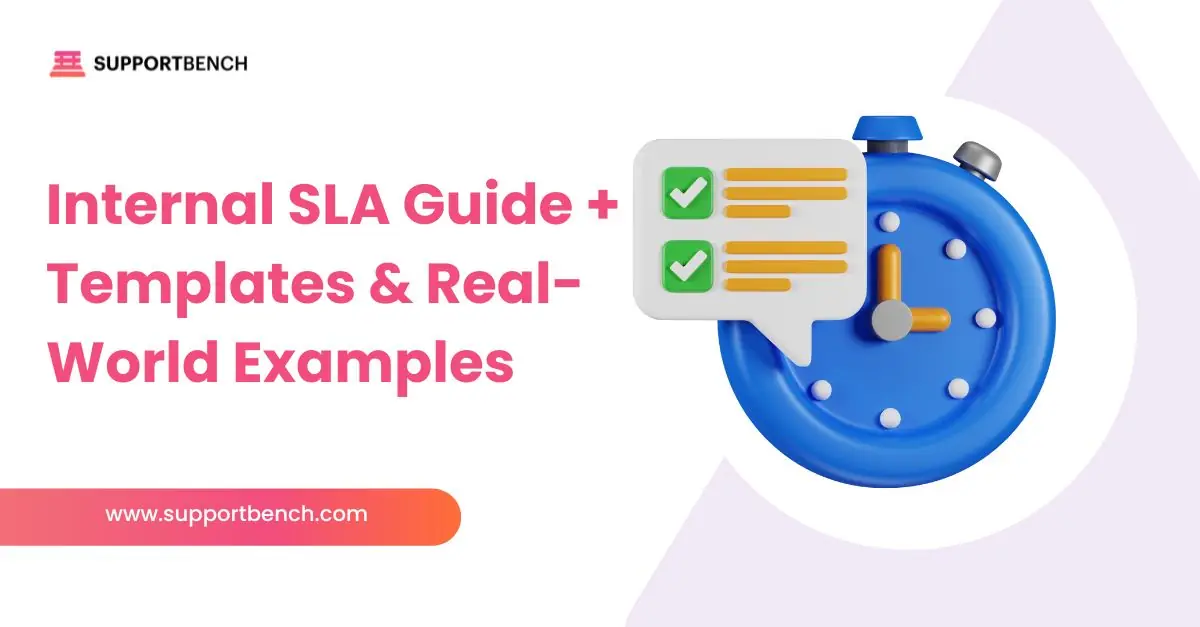Smooth collaboration between departments doesn’t happen by chance. It depends on clearly defined responsibilities, realistic expectations, and agreed-upon service standards. That’s where internal service-level agreements (SLAs) come in.
An internal SLA sets clear terms for how teams support one another—from expected response times to who’s responsible for what. When used properly, it prevents confusion, speeds up service, and keeps workflows predictable.
This guide walks you through creating an effective internal SLA, with easy-to-follow steps, a ready-to-use template, and real-world examples. You’ll also see how platforms like Supportbench help automate SLA tracking and simplify day-to-day management.

At a Glance:
Internal SLAs improve collaboration by setting clear expectations between teams. They define how quickly services should be acknowledged and resolved, who’s responsible, and what happens when targets aren’t met. Use a structured template to create your own, automate SLA tracking with tools like Supportbench, and review agreements quarterly to keep them relevant.
What is an internal SLA?
An internal SLA (Service-Level Agreement) is a documented commitment between two or more teams inside the same organization. It outlines what support is expected, how quickly it should be delivered, and who is responsible for making it happen.
Unlike external SLAs, which are customer-facing, internal SLAs help departments work together more efficiently—especially in fast-moving environments like IT, HR, or customer support.
For instance, your IT team might commit to resolving hardware setup requests from new employees within one business day. Or your HR department may pledge to respond to payroll inquiries within four hours.
Well-structured internal SLAs eliminate guesswork, reduce internal delays, and support better outcomes for both employees and customers.

Why Use Internal SLAs
Internal SLAs create more than just structure—they build accountability and reduce friction across departments. When expectations are clear, teams can work faster, with fewer misunderstandings and better outcomes.
Here’s why they matter:
✔ Clarity of Roles: Everyone knows what they’re responsible for and when, so nothing slips through the cracks.
✔ Reliable Timelines: Clear response and resolution targets help teams prioritize tasks without guesswork.
✔ Smarter Collaboration: Shared expectations reduce back-and-forth and help departments align, especially in cross-functional workflows.
✔ Better Accountability: With agreed escalation paths and documented timelines, teams take ownership of their tasks—and know when to act.
✔ Improved Service Quality: When internal requests are handled smoothly, employees can do their jobs more effectively, ultimately improving the customer experience too.
When implemented well, internal SLAs don’t just speed things up—they improve how your organization works together.
Step-by-Step Guide to Creating an Internal SLA
Setting up an internal SLA doesn’t have to be complicated. Follow these steps to create agreements that are clear, measurable, and easy to manage:
1. Identify the Teams and Services Involved
Start by clarifying which departments are part of the agreement. Is IT supporting HR? Is Customer Support depending on Legal for compliance questions? Define the relationship clearly.
Also, outline what services are covered—such as hardware support, access requests, or account provisioning.

2: Define the Metrics You’ll Track
Choose simple, actionable metrics. Common choices include:
- First Response Time (how quickly a request is acknowledged)
- Resolution Time (how long it takes to resolve the issue)
- Escalation Rate (how often issues need to be handed off)
3. Set Specific Time Targets
Assign realistic targets to each metric based on priority and business context.
For example:
- Critical issues: 30-minute response, 2-hour resolution
- Standard requests: 2-hour response, 1-business-day resolution
4. Assign Roles and Responsibilities
Clearly state who’s responsible for what:
- Agents: Handle tickets and provide updates
- Managers: Monitor metrics and handle escalations
Also, define what happens if timelines are missed—who steps in, and how?
5. Outline Tools and Processes
Document the systems and workflows used to enforce the SLA.
Mention:
- Ticketing platform (e.g., Supportbench)
- Notification rules
- Reporting dashboards
This ensures everyone follows the same playbook.
6. Define Breach Protocols
If timelines are missed, specify next steps. Examples:
- Escalate to a supervisor
- Notify stakeholders
- Trigger a review or retraining session
7. Review and Refine Regularly
SLAs aren’t static. Reassess them quarterly to make sure targets are still relevant and achievable. Gather feedback from teams and adjust as your business evolves.
Simple Internal SLA Template (Example)
A practical SLA doesn’t need to be complex. Here’s a straightforward template you can adapt to your internal teams. Use it to align expectations, streamline ticket handling, and create accountability.
Internal SLA Agreement
Service Team: IT Helpdesk
Receiving Team: Sales Department
Services Covered:
- Software and hardware technical support
- Troubleshooting system issues
- User account access setup and modifications
Service Level Targets:
Priority | First Response Time | Resolution Target |
Critical | 30 Minutes | 2 Hours |
| High | 1 Hour | 4 Hours |
Standard | 2 Hours | 1 Business Day |
| Low | 4 Hours | 2 Business Days |
Escalation Protocol:
If targets are missed, the ticket is escalated to the IT Support Manager and flagged for review. Supportbench can automate this process by sending alerts and reassigning overdue tickets automatically.
Responsibilities:
- Service Team: Respond to and resolve tickets based on priority. Maintain ticket updates and escalate when necessary.
- Receiving Team: Submit clear, detailed requests through the ticketing system. Respond promptly when follow-up info is requested.
➤ Tip: Use Supportbench to enforce these SLAs through system-based triggers, auto-escalations, and real-time dashboards. This removes guesswork and ensures the SLA stays top of mind across teams.

Real-World Internal SLA Examples
While every internal SLA will be specific to your teams, your structure, and the tools you use, here are three practical, real-world examples showing how organizations approach internal service agreements.
These examples demonstrate different approaches, from system-based automation to formal documentation, so you can find the right fit for your environment.
1. Supportbench SLA Setup Example
Supportbench approaches internal SLAs by building them directly into team workflows. Instead of relying on long-form documentation, SLAs are configured inside the platform to ensure that response targets, escalations, and priorities are automated and enforced in real time.
What Stands Out:
SLAs are operational—not just theoretical. They are tied directly to ticket properties and enforced automatically through Supportbench’s workflow engine. This results in high visibility and low administrative overhead.
Key Features:
✔ SLA rules are tied to case priority (e.g. critical cases trigger a 30-minute response target).
✔ Escalations fire automatically when thresholds are at risk.
✔ Managers can manually adjust SLAs to account for special circumstances, such as team absences or off-hours.
How You Can Apply This:
If your team uses Supportbench or any platform with built-in SLA enforcement, define response and resolution targets directly in the system, not on static documents. Automate alerts, escalations, and reporting to reduce manual oversight and increase accountability.1
2. Adobe Internal SLA for Technical Support Example
Adobe’s publicly available customer SLAs offer a useful model for internal teams, particularly IT or technical support. Though designed for external clients, the same structure applies well inside organizations.
What Stands Out:
Clear prioritization tiers based on business impact ensure everyone understands what qualifies as critical, urgent, or informational. The model prioritizes fast response to system-wide outages and high-value incidents.
Priority Example Structure:
Priority 1 (Critical): Major system outage or halted operations. Requires immediate attention.
Priority 2 (High): Significant disruption, partial functionality remains. Response needed within hours.
Priority 3 (Medium): General performance issues or delays. Business impact is moderate.
Priority 4 (Low): Cosmetic issues or feature requests. No operational impact.
How You Can Apply This:
Create similar internal tiers to help departments prioritize incoming support requests. Make sure ticket severity is clearly defined and team members know how to classify new requests properly.2
3. University of Saskatchewan IT Internal SLA Example
This example, published by the University of Saskatchewan, outlines formal internal SLAs between IT and other university departments. It includes timelines, response targets, and incident classifications that can serve as a model for large institutions.
What Stands Out:
The SLA structure reflects an enterprise IT support environment. It defines response hours, triage timelines, and expectations for communication during outages or major incidents.
Key Elements:
Support Hours: Monday to Friday, 8:00 a.m. to 5:00 p.m.
Response Expectations:
- Critical classroom incident: triage within 1 minute, resolution within 15 minutes.
- Major incidents: response in 90 minutes, resolution in 4 hours.
Performance Goals:
- 90%+ of tickets to be responded to within SLA windows.
- Fewer than 3% of tickets reopened after resolution.
How You Can Apply This:
Use this structure if you’re working in public sector, education, or complex enterprise environments. Establish standard operating hours, publish measurable service targets, and integrate SLAs into department planning and policy reviews.3

Handling SLA Breaches
SLA breaches are inevitable in any operational environment. The key isn’t to avoid them at all costs, but to detect, manage, and learn from them. A proactive SLA breach strategy minimizes disruption and builds internal trust.
Detect Early
Use SLA tracking tools to trigger early warnings—not just alerts when a breach occurs. Platforms like Supportbench allow real-time monitoring of ticket status and can notify team leads before an SLA is breached, allowing time for preventive action.
Analyze the Cause
Not all breaches are equal. Some stem from staffing shortages, others from misrouted tickets or poorly defined priorities. Investigate:
- Was the ticket triaged correctly?
- Was the escalation path followed?
- Were team members overloaded or unavailable?
This analysis reveals root causes—not just symptoms.
Respond Quickly
Once a breach occurs, timely acknowledgment is essential. Actions might include:
- Reassigning tickets
- Notifying the requester about delays
- Holding a brief post-breach team sync
Quick intervention protects team credibility and prevents frustration from escalating.
Update the SLA if Needed
Frequent or repeated breaches may indicate unrealistic SLA targets. Adjusting the agreement—by revisiting resolution times, redefining priorities, or allocating additional resources—can restore SLA performance without sacrificing quality.
➤ Supportbench users can automate many of these steps, including early breach alerts, escalation triggers, and breach log reporting for regular review.
Best Practices for Internal SLAs
Strong internal SLAs improve coordination, reduce frustration, and help departments meet their service commitments without unnecessary overhead. But for SLAs to work well in practice, they need to be realistic, understood by all, and revisited regularly.
Start Small
Don’t try to define 20 metrics right away. Start with one or two high-impact KPIs, like First Response Time or Resolution Time. Once these are stable, expand coverage to more service types or metrics.
Build a Stronger Team
Internal SLAs only work if everyone understands them. Hold brief onboarding sessions for new team members, and make SLA terms visible inside the tools your teams use (like ticketing dashboards). Assign SLA ownership for ongoing monitoring and reporting.
Keep It Updated
Review SLAs at least quarterly. As team size, business needs, or request volumes change, so should your targets. Don’t wait for repeated breaches to trigger a revision—be proactive.
Automate Where Possible
Manual SLA tracking leads to missed thresholds and administrative drag. Use a helpdesk solution like Supportbench to:
✔ Set timers for different SLA types
✔ Auto-escalate tickets nearing breach
✔ Generate SLA performance dashboards
✔ Send daily or weekly summaries to team leads
Automation frees up agents to focus on service—not spreadsheets.
Conclusion
Internal SLAs help teams move beyond informal expectations and into clearly defined, measurable service standards. They clarify responsibilities, reduce miscommunication, and provide a framework for accountability across departments.
Whether you’re coordinating between IT and HR, support and engineering, or any other internal function, having defined SLA targets ensures consistent performance, faster resolutions, and smoother collaboration. But for SLAs to succeed, they need to be realistic, visible, and enforced with the right tools—not buried in static documents.
Supportbench simplifies this process by offering built-in SLA management, automated escalations, and real-time performance monitoring—all in a single, easy-to-use platform. From setup to ongoing reporting, it helps internal teams maintain service excellence without added administrative overhead.
Ready to take control of your internal service standards? Book a demo or start your free trial with Supportbench today.















